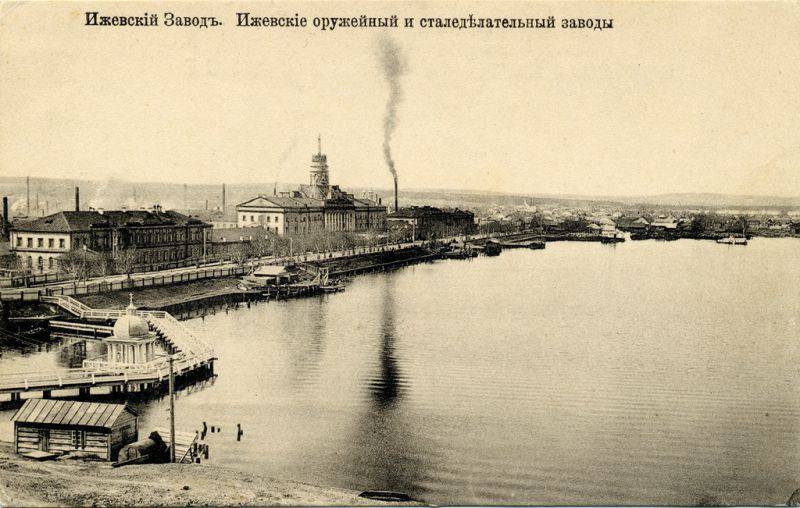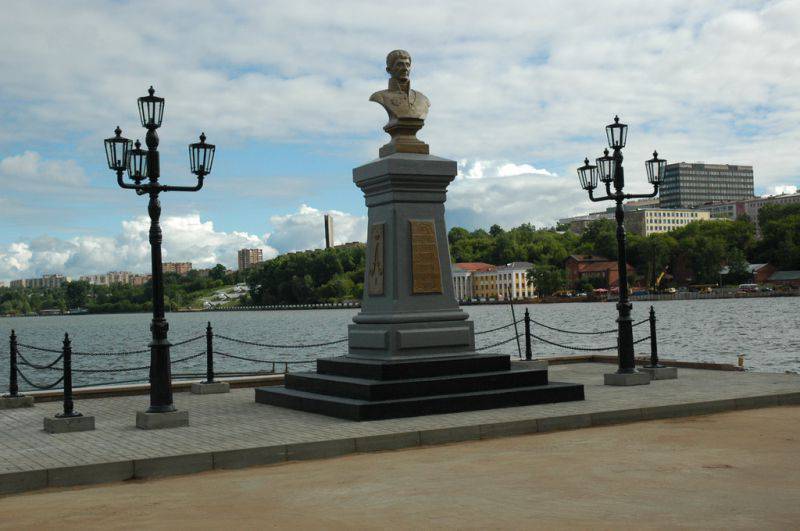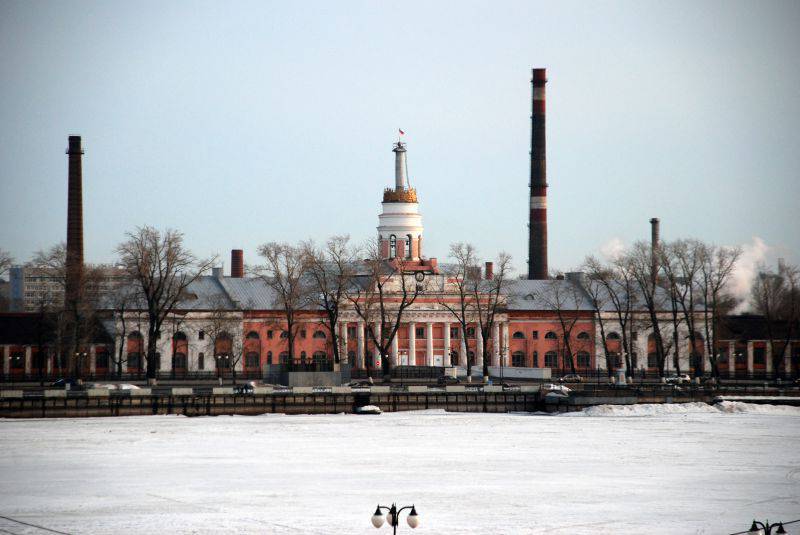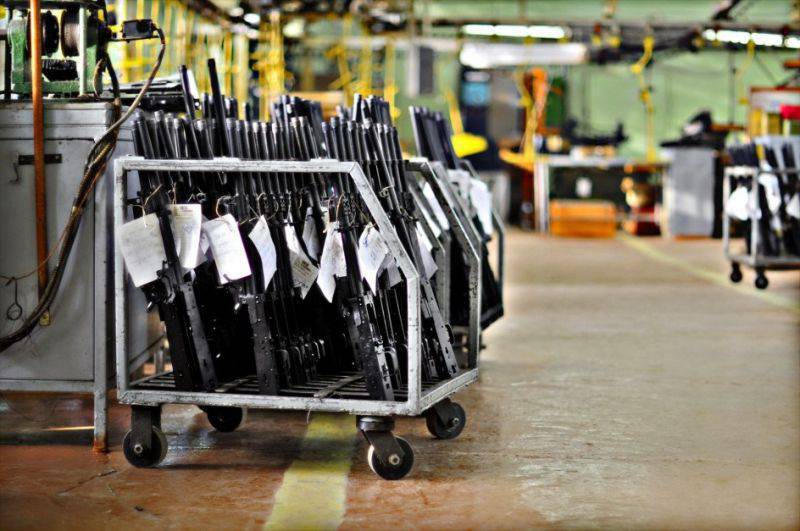10 June 1807 was founded Izhevsk Arms Factory
Founded in June 1807, the Izhevsk Arms Plant, according to the plan of its creator, Oberberggauptman Andrei Fedorovich Deryabin, was to become one of the most advanced industrial enterprises in Russia at that time. The organization of factory premises and production cycles initially assumed the creation in Izhevsk of a powerful, using a large number of mechanisms and machines, the mass production of small arms. Even then, the Izhevsk plant was distinguished by the highest concentration of production capacity. This feature was the main difference between the Izhevsk enterprise and the weapon centers in Tula and Sestroretsk that already existed in those years. For example, in those years at the Tula Arms Plant in state-owned factories only individual “machine work” was carried out, and everything else was done at home. Another thing - Izhevsk. Here, the entire issue of small arms initially went to 14 stone buildings located on a single factory site. At the same time most of the gunsmiths worked in one huge building - the main building of the plant, which was one of the first high-rise industrial buildings in the whole world. In the main building there was a clear division of production. Already in the very first years of the existence of the Izhevsk Arms Plant, its shop structure was formed: locking, barreled, instrument, lozhevoi, bayonet, tool, steel artel and workshops.
By the beginning of World War 1812, the release of small arms and cold arms for the tsarist army was already in full swing in Izhevsk. During the first 4 of the year of its existence, the plant managed to produce two thousand guns, and already during the war with Napoleon, the company supplied the army of Mikhail Kutuzov with more than 6 thousand silicon guns, increasing the volume of the initial release of weapons 10 times. In 1814, in Izhevsk, 10 thousands of guns and almost 2,5 thousands of hacksacks were already assembled. At the same time, the advanced production organization at that time allowed for a reduction in the cost of weapons produced by 1,5 times as compared with weapons produced in Tula.
At its design capacity, the plant, which was designed to produce 25 thousands of flintlock guns and 5 thousands of saws annually, was released by the 1830 year. In total, over 1830 a year, more than 26 thousand guns were assembled in Izhevsk, and in 1836, the company overcame a new production line, having already produced 30 thousands of guns in a year. A significant contribution of gunsmiths from Izhevsk to the development of all weapons technology was the unification of all parts of the gun. Thus, in Izhevsk Arsenal, the process of dismantling a dozen guns was often demonstrated to visitors, after which all parts were mixed, and then normally working guns were assembled again. Andrey Deryabin himself obliged to carry out such checks at the plant. In this regard, an analogy with another weapon — the Kalashnikov assault rifle, which the plant will start producing in a century and a half — involuntarily comes. Even today, our contemporaries once again amaze this “trick” when the details of ten machine guns are intermingled with each other, after which of them 10 perfectly working weapon models are assembled again. Without a doubt, the tradition of reliability of Izhevsk weapons was laid in the first half of the XIX century since the founding of the plant and passed down from generation to generation.
Up to the fifties of the nineteenth century, flint guns were made in Izhevsk, converted into impact-caps. But after the Crimean War 1853-55, which showed the lag of the Russian small arms in the rate of fire and the range of the battle, the Izhevsk plant began the transition to breech weapons of the Krnka system. And in 1874, the plant mastered the production of the four-line rifle Berdan. In 1870-80, the production of Berdan rifles was brought to 300 thousand pieces per year. At full capacity, the plant began to work during the Russian-Turkish war 1877-1878. Only in 1878, the Izhevsk Arms Factory produced 162 455 of such rifles. It is the small-caliber four-line rifle of the Berdan system, which was produced in Izhevsk from 1874 to 1890 years, became the most popular product of the plant of those years.
At the same time, the look of the enterprise also changed. In many ways, the change in appearance was due to the fact that in 1867, gunsmiths in Izhevsk received their freedom, and, starting this year, the plant was given to lease-commercial management. The tenants of the Izhevsk enterprise, among whom was the brother of the famous inventor Ludwig Nobel, managed to change the enterprise considerably and for the better. During the years of lease, the Izhevsk Arms Plant was converted to a significantly larger annual production volume (up to 70 thousand guns annually), the existing machine park was seriously developed, and the power industry made a big step forward. Here, for the first time, a telegraph station was opened, telephone lines were stretched, and its own in-plant rail transport appeared. Already in 1870, the Izhevsk Arms Plant produced more weapons than the Tula and Sestroretsky plants combined. Later, with the development of the production of high-quality steel in Izhevsk, local gunsmiths became the only suppliers of weapon barrels and receiver boxes for the rest of the country's enterprises. For example, Tula received from Izhevsk to 360 thousand trunks per year.
By 1907, by the centenary of the enterprise, more than four million different weapons were produced at the plant. As part of the celebrations, which were dedicated to the centenary anniversary of the plant, a monument to Andrei Deryabin was erected in Izhevsk. By 1907, Izhevsk had developed three modifications of the legendary Mosin rifle, which was produced from the 1892 of the year: infantry, Cossack and dragoon. Also local gunsmiths developed a Mosin carbine. All of these samples of small arms produced in series. For many years, Izhevsk weapons factory owed its glory to Mosin’s magazine-assisted rifle. In various cases, this rifle was in mass production in Izhevsk for more than half a century. At the same time, the plant in Izhevsk was the only one in the country where all the varieties of the famous three-line design were produced. In total for 1892-1945 years in Izhevsk 56 million 793 thousands of 640 units of small arms of the Mosin system were assembled.
The next stage in the mobilization of power and workers was the First World War. During the war years, a number of transformations were carried out at the Izhevsk plant, both in the arms and steel industries. At the same time, the number of workers increased immediately in 3 times, along with men, women and children began to work at the plant. Factory capacity was able to expand by half. In total, during the years of World War I, the Izhevsk plant put 1 million 400 thousands of new rifles and almost 188 thousands of fixed to the front of the 1917. By the summer of 34, the XNUMX had already employed thousands of people in the factory. On the scale of concentration of labor and production, the Izhevsk Arms Factory on the eve of the first Russian revolution was one of the first places among all enterprises of the Russian defense industry, being one of the most powerful enterprises of the entire Russian Empire.
However, the revolutionary years have made their adjustments in the life of the plant. In the first years after the October Revolution, the 4 plant changed hands several times. The first time it happened in August was 1918, when the famous Izhevsk-Votkinsk uprising against the Bolsheviks thundered here. However, in November of the same year, the forces of the rebels were suppressed by the Red Army, which took the city and the plant. But in April, 1919, the plant was in the hands of the advancing troops of Admiral Kolchak, whom the Bolsheviks drove from Izhevsk in June of the same year. The fighting affected the state of the plant: during these years most of the existing equipment was disabled or removed from the plant. A very sensitive blow was also inflicted on skilled factory personnel. Despite these difficulties, the company was able to retain its potential, and in August 1920 had collected thousands of rifles here in August, among other things, during the Civil War, new products were launched here: cartridges, barrel boxes for Fedorov’s machine guns. In 48, the issue of hunting weapons is resumed here. The development of metallurgical production, as well as the release of a diverse tool. Immediately after the completion of all the hostilities, in the autumn of 1921, a five-year program of rehabilitation of the enterprise was prepared, it was reconstructed, cleaned and converted.
In 1930, an independent machine-tool production was opened at the Izhevsk Machine-Building Plant (Izhmash), and a new woodworking workshop appeared. In the same year, the first machines were produced here. In 1933, on Izhmash, for the first time in the USSR, 5 powerful crankshafts were manufactured from special steels, including for the An-1, ANT-25 and other aircraft. In April, the New Design Bureau (BNK) was opened at the plant 1933. From that moment on, all the developments in the field of creating weapons were in it. Nowadays, these works are carried out in the Concern's design and weapons center.
During the Great Patriotic War of 1941-1945, up to 18 types of various weapons were produced in Izhevsk, including the anti-tank rifles of Simanov and Degtyarev, aviation guns and machine guns Berezin, aircraft guns Nudelman-Suranov and Shpitalnogo. In those years, thousands of people worked on Izhmash, and the production amounted to millions of weapons - from conventional rifles to aircraft guns. At the same time, the release of weapons was growing rapidly. Already in 1941, every day the company produced 12 thousand Mosin-designed rifles, so every day the Izhevsk plant armed a full-fledged rifle division. And in 1945, the release of weapons increased almost 3 times compared to 1941. In total, over the four war years in Izhevsk, small arms were produced more than 92 years before the Great Patriotic War combined. During World War II, more than 11 million rifles and carbines, more than 130 thousand anti-tank rifles and more than 15 thousand aviation guns were assembled here. At the same time, over the years of the war, the Izhmash team was awarded 10 times the passing Red Banner of the winner in the All-Union Socialist Competition, which emphasized the labor exploits of Izhevsk gunsmiths. Moreover, in 1942 the plant became the first order-bearing enterprise in the Udmurt Republic: on January 18, Izhmash was awarded the Order of Lenin. And on October 20, 1944, the enterprise was awarded the Order of the Red Banner. For permanent storage, the Izhevsk factory was handed the Banner of the State Defense Committee (GKO).
And after the war, starting with 1948, the era of production of a Kalashnikov assault rifle, which is still in service with the Russian army and armies in many countries of the world, began at Izhmash. Today it is the AK and its modifications that are the most common small arms in the world. According to available estimates, this type (including licensed and unlicensed copies, as well as AK-based models) is 1 / 5 of all small arms on the planet. Over the 69 years in Izhevsk, more than 70 of millions of Kalashnikov assault rifles were produced. These machines are in service with 50 foreign armies. The main competitor of the AK is the American MNNX automatic rifle, which was produced in the amount of approximately 16 million copies and is in service with the 10 armies of the world. At the same time, according to many experts, AK is the standard of ease of maintenance and reliability in the world of small arms. On its basis, a whole family of models of combat and civilian weapons of various calibers was created, including a Kalashnikov light machine gun (PKK) and Saiga smoothbore guns.
Today, the plant, which in 2015 has already celebrated its 208 anniversary, bears the name of legendary designer Mikhail Timofeevich Kalashnikov, who worked at this Izhevsk plant until the end of his life. 13 August 2013 NPO Izhmash was renamed Concern Kalashnikov OJSC, which is the parent company of Rostec GC holding company. With the renaming of the enterprise and its entry into the new group, work towards modernizing and improving production will be strengthened. In the future, the concern should combine the Izhevsk Mechanical Plant OJSC, the Molot machine-building plant Molot, the Progress NITI, the Leningrad Koshkin KBAL and a number of other domestic enterprises in the arms industry. The Izhevsk enterprise plans to annually develop and present new products to 2-3 end-users, which would meet the requirements of customers and the challenges of the time. One of the latest innovations of Izhevsk gunsmiths is the AK-12. According to the press service of the concern, in the framework of the Army-2015 forum, the residents of Izhevsk will present the latest version of the AK-12 machine gun, as well as a civilian carbine with the combat potential of the AK-15 development, which was created this year on the basis of the Saigi MK 107.
Information sources:
http://kalashnikovconcern.ru
http://vkyrse.com/event/361
http://www.by-time.ru/events/detail.php?ID=4882
http://www.calend.ru/event/3696




Information